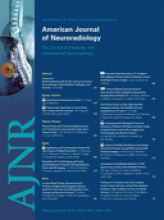Heat stroke is a critical illness characterized by hyperthermia (elevated core body temperature >40°C) with accompanying life-threatening complications. Previous MR imaging findings of heat stroke included diffuse atrophy of the cerebellum1; hyperintense lesions in the cerebellum,1–3 external capsule and adjacent lateral putamen,2 medial thalamus,2 and hippocampus3; and patchy cortical lesions in the frontal and parietal lobe.3 However, to our knowledge, the findings of diffusion-weighted imaging (DWI) and apparent diffusion coefficient (ADC) mapping in patients in the early stage of heat stroke have not been reported. We describe a patient with heat stroke, with increased signal intensity in the cerebellar dentate nuclei and splenium on DWI.
A 41-year-old man was admitted to the hospital in a comatose state, with high fever and respiratory failure. He had been working in a greenhouse for 3 hours on a hot and humid day just before the admission. DWI and ADC mapping on day 4 revealed restricted water diffusion in the bilateral dentate nuclei (312 × 10−6 mm2/s, Fig 1A, -B) and splenium of the corpus callosum (338 × 10−6 mm2/s, Fig 1C, -D). T2-weighted imaging (T2WI) showed slightly increased signal intensity only in the splenium of the corpus callosum. Follow-up DWI and T2WI, performed on the 21st day, revealed no signal intensity abnormality. However, the last follow-up MR imaging, performed on the 90th day, revealed cerebellar atrophy.
The present case showed symmetric and bilateral lesions in the splenium and cerebellar dentate nuclei. The involvement of dentate nucleus and splenium in our patient was very similar to the case of metronidazole-induced encephalopathy.4 Our patient had restricted water diffusion in the cerebellar dentate nuclei and splenium, which suggests that cytotoxic edema occurs early in developing heat stroke. The mechanism of cytotoxic edema in heat stroke is controversial. It may be related to hyperthermia-induced vasoconstriction and resultant cerebral ischemia or direct cytotoxicity of heat or both. In our patient, the last follow-up MR imaging, performed on the 90th day, revealed tissue loss in the cerebellar structures. These findings indicate that cytotoxic edema leads to delayed irreversible neuronal damage in the cerebellum. In conclusion, our case demonstrated that heat stroke causes irreversible neuronal damage, especially in cerebellum.
Initial DWI and ADC map reveal restricted water diffusion in the bilateral dentate nuclei (A and B) and splenium of the corpus callosum (C and D).
- Copyright © American Society of Neuroradiology








